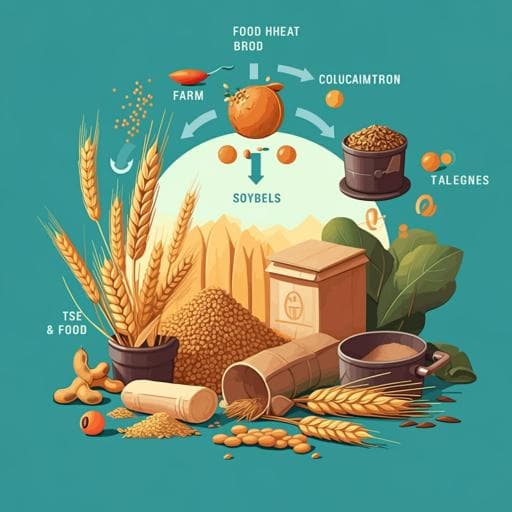
Food Science and Technology
Assessment and scenario hypothesis of food waste in China based on material flow analysis
S. Jiang, H. Chen, et al.
Discover how Shiyan Jiang, Hong Chen, Suhan Yang, Yujie Wang, and Ming Xu reveal the staggering food waste in China between 2010-2019, with wheat leading the charge at 38% waste. This research not only highlights the crucial stages of food loss but also offers a path to reducing soybean imports by 7% through effective waste management strategies.
~3 min • Beginner • English
Introduction
Food loss or waste occurs at all stages of production, storage, transportation, processing, and consumption and contributes significantly to global food system insecurity and environmental impacts. Emerging economies, including China, face rapid shifts in consumption and food loss and waste (FLW) structures due to urbanization and income changes, with China among the top countries in FLW and associated GHG emissions, despite constrained resources and its role in feeding a large share of the world’s population. The UN’s SDG Target 12.3 calls for a 50% reduction in food waste at retail and consumer levels by 2030, making China’s role critical. Existing empirical studies often focus on partial supply chains or limited food categories, with outdated data and small samples, especially lacking comprehensive coverage for vegetables, aquatic products, and milk at different stages. China’s 2021 Anti-Food Waste Law lacks specific quantitative targets partly due to limited knowledge of waste patterns by category and stage. This study applies material flow analysis (MFA) to systematically assess waste magnitude across five stages (production, postharvest handling and storage, processing and packaging, distribution, and consumption) for seven food categories in China (2010–2019) to identify intervention points and evaluate soybean import reduction under waste-reduction scenarios. It addresses three challenges: tracking flows and inventories along the supply chain, analyzing waste structures by category and stage, and predicting the potential to reduce reliance on soybean imports. The FAO definition is adopted: food loss is unintentional reduction during the supply process; food waste is intentional discarding of food intended for human consumption at different stages (excluding non-food uses such as feed and seeds).
Literature Review
Prior studies in China estimate substantial waste at consumption and along meat and rice supply chains (e.g., pork/chicken/beef/lamb losses of 8.1%, 11.22%, 1.47%, and 7.45%; rice total loss and waste 13.64% with 5.22% at consumption). However, whole-chain studies for vegetables, aquatic products, and milk remain scarce; many rely on outdated or small-sample data. Consumer-stage waste has been measured via four approaches: bookkeeping, bin ‘archaeology’, plate weighing, and inference from secondary data—each with trade-offs in accuracy, intervention level, and feasibility. MFA has been less commonly used in FLW but offers low respondent interference, scalability, and the ability to reveal flow patterns and hotspot stages. International MFA applications include EU product-group food waste quantification, environmental impact assessments (e.g., North Korea), Japanese food loss rate identification (highest for vegetables), flight catering waste (vegetables 47.58%), and sector-specific analyses (Italian potatoes), showing the method’s utility but limited deployment, especially in China. Additional related work links food supply chains to energy use, and shows upstream FLW causing significant GHG emissions, underscoring the need for comprehensive, up-to-date, and stage-specific assessments in China.
Methodology
Design: The study applies Material Flow Analysis (MFA) to quantify stocks, flows, and waste across China’s food supply chain for seven representative food categories—wheat (grain), soybeans (pulses), apples (fruit), tomatoes (vegetables), pork (meat), freshwater fish (aquatic products), and liquid milk (dairy)—over 2010–2019. The system spans five stages: agricultural production, postharvest handling and storage, processing and packaging, distribution, and resident consumption (tourist consumption accounted for separately). Imports are included at the processing/packaging stage (reflecting predominantly unprocessed imports) and exports at the distribution stage (often processed). Non-food uses (feed, seed, other) are recognized primarily after production/handling and excluded from edible food flows. Only edible portions are considered. Spatial boundary: China (including mainland, Hong Kong, Macau, and Taiwan). Temporal boundary: 2010–2019. Data sources: Primarily FAO Food Balance Sheets (FAOSTAT) for production, trade, and availability, supplemented by national statistics and prior literature for parameterization. Waste rates (k values) by stage are taken from prior studies (provided in Supplementary Table 4). Tools: STAN 2.5 software (Substance Flow Analysis) used to implement MFA and ensure mass balance. Assumptions: The system is treated as steady-state with no net accumulation outside the system; stored food moves through to consumption within the period considered. Tourist consumption is separated from resident consumption. Method and equations: Based on mass conservation, flows (F), stocks (S), wastes (W), and stage-specific waste rates (k) are related via balance equations across stages (e.g., W1 = k1*S1; balances linking S1–S5 with flows, imports I, exports E, tourist consumption T, and other flows L1), ensuring inputs equal outputs plus changes and losses. The framework tracks category-specific flows through each stage (Fig. 5 in paper), attributing waste volumes by stage and aggregating across 2010–2019 to derive annual averages. Scenario analysis: A uniform 5% reduction in waste at each of the five stages is imposed for soybeans to estimate impacts on import demand via recalculated material balances (Fig. 4). Outputs: For each category and stage, the study quantifies average annual stocks, flows, and wastes; aggregates by stage and by category; computes production utilization indicators; and evaluates scenario-driven import changes.
Key Findings
- Overall magnitudes (2010–2019 annual averages): Wheat had the largest production stock and the highest average annual waste at 45.7 Mt, accounting for 38% of total waste across the seven categories. Tomatoes contributed 19%, apples 13%, pork 10%, freshwater fish 8%, soybeans 8%, and milk was the lowest at 4.3 Mt (4%). - Temporal trends: Tomatoes and freshwater fish exhibited increasing total waste across stages, with average annual increases of ~4% and ~2%, respectively. Pork waste declined from 2014 onward at an average annual rate of ~2%, potentially reflecting higher meat prices and evolving dietary preferences (e.g., vegetarianism). - Non-food uses: Annually, 24.1 Mt of wheat (≈19% of wheat production) are used for feed, seed, and other uses; soybeans 9.3 Mt (≈69% of production) primarily for feed/seed with substantial imports for animal feed; freshwater fish 0.7 Mt (≈3%); milk 0.2 Mt (≈0.5%). Fruits and vegetables have no non-food uses. - Stage hotspots by category and cross-category shares: • Wheat dominated waste at postharvest handling & storage, processing & packaging, and consumption stages. Across all seven categories, wheat accounted for 56% of total postharvest/handling/storage waste, 36% of processing/packaging waste, and 48% of consumption-stage waste. • Tomatoes had the highest waste shares at production and distribution (marketing) stages (28% and 25% of stage totals, respectively). - Category-wise stage profiles: • Most waste occurred at the consumption stage for wheat, apples, tomatoes, pork, and milk. • Soybeans’ largest waste fraction was at processing/packaging (46% of soybean waste). • Freshwater fish waste was concentrated at the production (farming/fishing) stage (37% of fish waste). - Drivers and context: Wheat waste is linked to short harvest windows, over-maturity at harvest, limited mechanization quality (despite 82% machine harvest rate), pests/diseases, and inadequate storage/processing infrastructure. Tomato and fruit/vegetable wastes are exacerbated by perishability and limited cold chain/storage infrastructure. Meat distribution wastes reflect high perishability and long transport distances. Consumption-stage wastes are influenced by cultural norms (e.g., over-ordering linked to social status) and immature regulatory frameworks. - Production utilization: The study indicates soybeans have particularly low production utilization due to heavy import reliance and processing-stage losses. - Soybean import scenario: A 5% waste reduction at each of the five stages yields an estimated 7% reduction in soybean imports, highlighting a sizable import dependency mitigation potential through waste reduction. - Market context: In H1 2021, China imported 48 Mt of soybeans (+8% YoY), underscoring rising import reliance. - Policy-relevant patterns: Consumption-stage waste dominates across many categories and is particularly severe in China per UNEP’s Food Waste Index 2021; tomatoes and wheat emerge as priority categories given their large and/or rising waste shares, with distinct stage-specific intervention points.
Discussion
Applying MFA across China’s food supply chain quantified where and how much waste occurs, addressing gaps in whole-chain and multi-category coverage. The findings identify critical intervention stages—postharvest, processing/packaging, and consumption for wheat; production and distribution for tomatoes; processing for soybeans; and production for freshwater fish—thus directly informing targeted policies and infrastructure upgrades. The dominance of consumption-stage waste across several categories highlights the need for behavioral and regulatory measures (e.g., anti-waste campaigns, portion-sizing, pricing/penalty mechanisms) alongside supply-chain optimization. The soybean scenario demonstrates that modest, uniform waste reductions can materially reduce import needs (≈7% decrease), indicating that waste mitigation is a viable lever for enhancing food security and reducing exposure to international market volatility. The MFA evidence thus supports prioritizing investments in mechanization quality and storage infrastructure (for grains), cold-chain/logistics improvements (for perishables), process innovation and byproduct utilization (for soybeans and dairy), and consumer-facing initiatives to curb over-ordering and improve food utilization. These measures align with SDG 12.3 and can also deliver co-benefits in GHG mitigation by reducing upstream resource use and emissions associated with wasted food.
Conclusion
This study provides a comprehensive, MFA-based quantification of food waste across five supply-chain stages for seven key food categories in China (2010–2019), revealing category- and stage-specific waste hotspots. Wheat accounts for the largest share of waste, with significant losses in postharvest/handling, processing, and consumption; tomatoes show high and rising waste, especially at production and distribution; soybeans concentrate waste in processing and exhibit strong import dependence; and most categories have major waste at the consumer stage. Scenario analysis shows that a uniform 5% reduction in stage-specific wastes can reduce soybean imports by about 7%, indicating waste reduction as a significant lever for food security. The study offers policy recommendations including setting category- and stage-specific targets, upgrading infrastructure and mechanization, promoting green supply chains and logistics, advancing processing innovations, and enacting consumer-focused measures to cut waste. Future research should expand to additional food categories, integrate higher-resolution, field-based loss measurements, refine dynamic stock assumptions beyond steady-state, and link MFA more tightly with environmental impact assessments and economic instruments to optimize interventions.
Limitations
- Data limitations: Reliance on FAO Food Balance Sheets and secondary sources may introduce uncertainties; waste rate (k) parameters are compiled from literature and supplementary sources, potentially varying by region and season. - Scope constraints: Only seven representative food categories were analyzed, focusing on edible portions; results may not generalize to all foods. - System assumptions: The MFA assumes steady-state conditions with no net accumulation outside the system and that stored food proceeds to consumption within the period; deviations could affect stage allocations. - Stage definitions and trade placement: Imports are modeled at processing/packaging and exports at distribution based on typical patterns; product-specific deviations may occur. - Consumer behavior and culture: Explanations for consumption-stage waste are inferential and may vary regionally; limited primary behavioral data. - Temporal coverage: Analysis covers 2010–2019; subsequent policy, market, and infrastructure changes may alter waste patterns. - Granularity: Country-level analysis may mask regional heterogeneity in infrastructure, practices, and losses.
Related Publications
Explore these studies to deepen your understanding of the subject.







